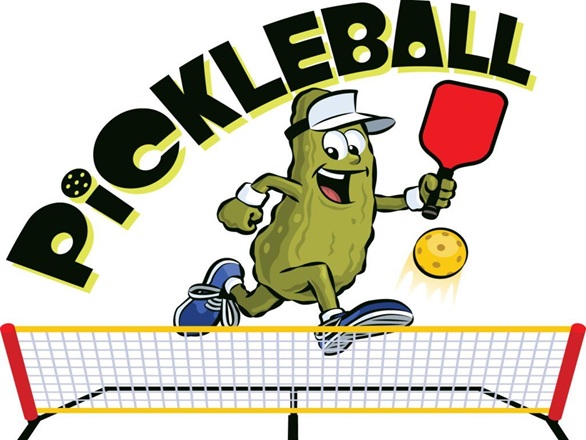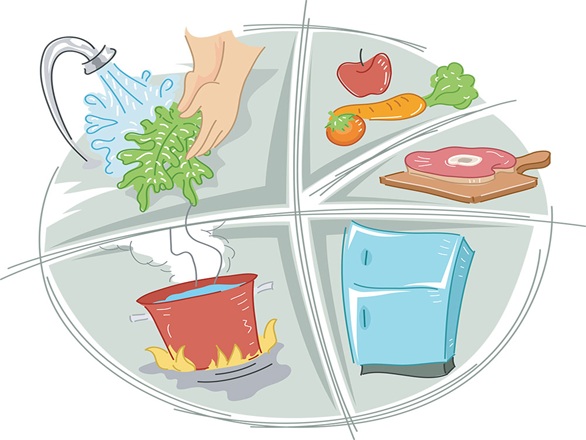In this edition
- The Pickle You’ll Want To Get In
To!
- Summer Food Safety
- Seven Super Steps to Safe Food in the Summer
About the Newsletter
Happy Summer! Start the summer off right by reading this newsletter on summer safety and summer food safety. You can also learn about Pickle ball and how popular the sport is getting.
The Pickle You’ll Want To Get In
To!
By Anne Lindsay
Crazy name! Crazy game! Crazy fun! Pickleball. A crazeall of its own. It’s the fastest-growing sport, but it hasnothing to do with pickles. It’s a cross between tennis, badminton, racquetball and maybe some ping pong. While the average playing age is around 35, pickleball is also popular among high schoolers and older adults (1 in 5 have played).
What makes this sport so popular? It is highly social, stimulates the brain, improves cognition and boosts mood, is a great workout and easy to learn. It has a slower ball speed and much less running than tennis, as there are four full pickleball courts inside one standard tennis court. This might lead one to believe it is a lowrisk injury sport. But think again. Increased game speed occurs with improved skill level and competition, both of which are a strong draw to the game, which can increase the risk of injury.

The most common injuries are strains and sprains (lower body more than upper body). Injuries are also more common among over 50 players. Many are new injuries, while others are flare-ups of old injuries or preexisting conditions. Recreational players that are also former athletes often play competitively and focus more on mastering the skill than spending time getting fit for the game.
Preventing injuries:
Pre-Game Warm-Up—Start with a five- to 10-minute warm-up of movements that simulate Pickleball play. This includes walking on the heel and toes to strengthen the ankles, forward skipping, side-to-side shuffles, squats, lunges and standing knee hugs to loosen up the lower body; and rotations of the wrist, elbows, arms and shoulders to loosen the upper body.
- Protective Eye Wear – While slower than hitting a tennis ball, pickleball involves hitting a hard plastic ball at speeds up to 40 mph. Eyewear protects you from a ball strike or even getting hit by you or your partner’s paddle.
- Good Shoes—Wear appropriate athletic shoes or sneakers with gummed rubber tread, which stick to the surface less. Pickleball requires a lot of side-toside movement, so ask a salesperson for an appropriate sneaker, not a running shoe, as running shoes are designed for forward movement.
- Check the Court – Do not play if it is wet or has cracks in the playing surface. Relocate items lying near the court such as towels, keys, water bottles, paddles or extra balls.
- Hydrate – Drink slowly, not all at once. Sip water for several hours before you play for better absorption.
- Take a break—Adults over 50 may require a longer warm-up and cool-down and more frequent rests.
And my #1 advice is don’t play to get fit; get fit to play! Cardio and weight exercises will strengthen your body for the game and reduce injury. This will help you spend more time on the court playing and less time on the couch nursing an injury!
New to Pickleball?
- Find a court - USA Pickleball runs a constantly updated database called Places2Play that lists available courts in the U.S. or download PicklePlay
- Find a group lesson @ Playpickleball
- Watch a free tutorial online
Summer Food Safety

Many of us head outdoors during the summer to enjoy picnics at the park or backyard barbeques. Along with the hamburgers and potato salad, don’t forget food safety. The Centers for Disease Control estimates that 48 million people each year get sick from eating contaminated food. Foods contaminated by harmful bacteria and viruses can cause a foodborne illness (food poisoning) and older adults and children are considered most susceptible. Foodborne illness can occur within 24 hours of eating contaminated food or days or weeks later. Common symptoms of foodborne illness include diarrhea, nausea, vomiting, abdominal pain and fever. Food can become contaminated when we transport, store, prepare or serve it. It is important to use food safety techniques during every contact stage with food.
USDA Safe Summer Meals Tips
Seven Super Steps to Safe Food in the Summer
During warm weather, it is important to take extra precautions and practice safe handling of food when preparing perishable foods such as meat, poultry, seafood and egg products. While warmer weather conditions may be ideal for outdoor picnics and barbecues, they also provide a perfect environment for bacteria and other pathogens in food to multiply rapidly and cause foodborne illness. Follow the suggestions below to Fight BAC!® (foodborne bacteria) and reduce the risk of foodborne illness this summer.
Summer Safety for Older Adults

Food Safety Clipart
- Wash, Wash, Wash Your Hands. Wash your hands with soap and water before handling food. If no wateris available, consider bringing your own water, soap and towels. If you can't wash your hands, use a handsanitizer containing at least 60% alcohol.
- Marinating Mandate. Marinate food in the refrigerator and don’t reuse the marinade on cooked food.
- Hot, Hot, Hot. When grilling foods, preheat the coals on your grill for 20 to 30 minutes or until the coals
are lightly coated with ash.
- Temperature Gauge. Use a food thermometer to ensure food reaches a safe internal temperature:hamburgers should be cooked to 160ºF, steaks to 145ºF, chicken breast to 165°F and fish to 145ºF.
- Stay Away From that Same Old Plate. Do not place cooked food on a plate that previously held raw meat,poultry, seafood or eggs; have plenty of clean utensils, plates and cookware on hand.
- To the Victor Goes the Spoils. Never let perishables (raw meat, poultry, eggs, cooked food, cut fresh fruitsor vegetables) sit at room temperature for more than two hours before storing them in the refrigerator orfreezer. When the temperature is above 90°F, store it for one hour.
- Icebox Etiquette. Always use a clean cooler filled with ice or an ice pack to keep food cold. A full cooler willmaintain cold temperatures longer. Placing drinks in a separate cooler can help you avoid opening andclosing the food cooler often.
- Hit the Road. When traveling, transport the cooler in the air-conditioned part of your car rather than in ahot trunk. This includes your groceries from the store, too.
- It's Lunchtime. A packed lunch with perishable items like meat, cheese or mayonnaise must be kept cold.An easy way to do this is to use a clean, insulated lunch bag with an ice pack.
View the Summer Safety for Older Adults fact sheet by typing “UNR Extension Summer Safety for Older Adults” in a search engine.
Published by:
Lindsay, A., 2025, Healthy LIVING while aging! (2025-07), Extension | University of Nevada, Reno, Newsletter
An EEO/AA Institution. Copyright ©
2025, University of Nevada Cooperative Extension.
A partnership of Nevada counties; University of Nevada, Reno; and the U.S. Department of Agriculture


